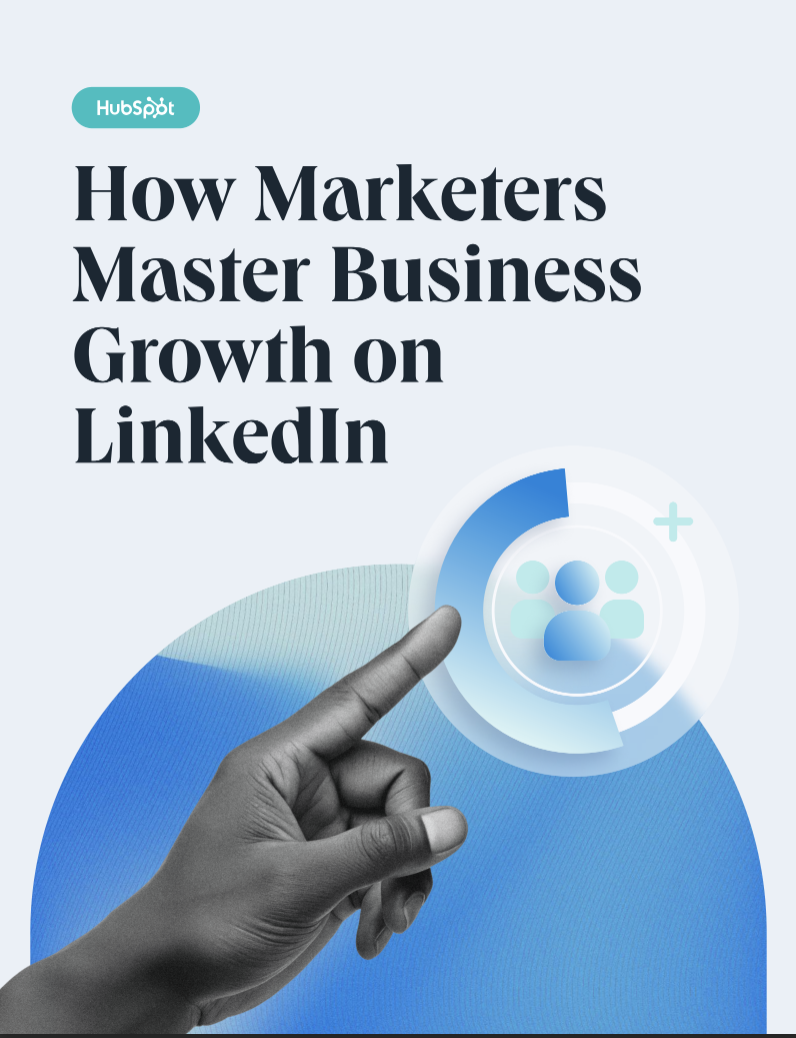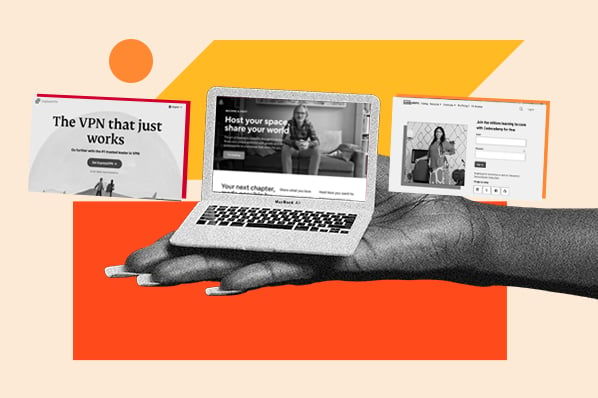Like many people, the first few years I was on LinkedIn, I used it as little more than an online résumé. In recent years, however, LinkedIn marketing has become one of the most reliable ways I generate leads, attract opportunities, and stay top-of-mind with the people who matter most.
When you treat LinkedIn like a marketing platform with the opportunity to reach over 1 billion users, not just a social network, it works hard for you — even when you’re offline.
LinkedIn is full of opportunities to build relationships, get more eyes on your content, and grow your business — when you know how to do it right. Let’s dive in so you can get started and turn it into a lead-gen machine.
Table of Contents
- What is LinkedIn marketing?
- LinkedIn Marketing Best Practices
- How to Use LinkedIn
- LinkedIn Posting Strategies
- LinkedIn Networking Tips
- LinkedIn Direct Messaging Tips
- How to Market on LinkedIn
- LinkedIn Marketing Options
What is LinkedIn marketing?
LinkedIn marketing is all about using the platform intentionally — to build your brand, grow your network, generate leads, and drive real business results.
For me, that’s looked like landing new clients, getting invited to speak on podcasts, and reconnecting with people I didn’t even realize were paying attention. When I treat LinkedIn like a core marketing channel — not just a place to share wins — it delivers.
Unlike other platforms, LinkedIn is built for this kind of work. It’s where people go to talk shop, share expertise, and connect with others who do what they do. And when you show up with a clear strategy, LinkedIn gives you the tools to amplify your reach — from analytics and SEO-friendly profiles to content distribution and search filters. I’ll walk you through exactly how I use them in a moment.

How To Use LinkedIn For Business And Marketing
Take control of your LinkedIn strategy with this free guide. You'll learn about...
- Maximizing visibility.
- Building a community.
- Paid vs. organic content.
- And More!
Download Free
All fields are required.

Why is marketing on LinkedIn important?
Most businesses focus their social energy on the big three: Instagram, Facebook, and TikTok. But if you’re looking to build relationships, attract quality leads, or establish your authority — especially in the B2B space — LinkedIn is where you want to be.
I’ve found that the quality of conversations I have on LinkedIn is higher than on any other platform — and the people reaching out usually already understand what I do. That’s not an accident. It’s the result of consistently showing up and using LinkedIn as part of my broader marketing strategy.
A stunning 96% of marketers prefer LinkedIn for lead generation over Facebook or X (formerly Twitter) because decision-makers are here — and they’re paying attention.
Whether you’re selling services, building your brand, or recruiting top talent, LinkedIn can help you do it more effectively — if you know how to use it right.
Just starting out? Here's a quick primer if you’re new to LinkedIn Marketing.
Now, let’s review the ways you can use LinkedIn to market and grow your business.
LinkedIn Marketing Best Practices
- Use hashtags.
- Know when to use a LinkedIn Profile vs. a LinkedIn Page.
- Create posts of varying lengths.
- Share external articles on the platform.
LinkedIn is one of the few platforms where you can build brand authority, attract qualified leads, and grow your business — all from one profile. But like any marketing channel, it works best when you use it with intention.
Here are a few of my top tips.
1. Use hashtags.
I’m not a big advocate of overusing hashtags on LinkedIn — they’re helpful, but they’re not magic.
Hashtags can help categorize your content for search and topic-based discovery and make your post visible to people who follow a specific hashtag (e.g., #RemoteWork or #Leadership).
However, they won’t magically boost your reach or engagement or replace good content.
That means you’ll want to strike a balance between relevant and popular hashtags by doing hashtag research on LinkedIn. Use the search bar to query a broad hashtag first.
You can’t always see follower counts directly on LinkedIn anymore, but you can see how often hashtags show up in feeds and who uses them by doing a quick search. Alternatively, social media tools often track hashtag metrics like reach, engagement, and frequency.
If you opt for hashtags, choose no more than three to five to reach your audiences and place them at the end of the post.

Pro tip: Some professionals like to create a series where they give business advice (in their niche) to their audience. To keep track of the advice, they create their own hashtags to represent their brand. You can do this, too!
2. Know when to use a LinkedIn Profile vs. a LinkedIn Page.
Your personal LinkedIn Profile and your company Page serve very different purposes — and if you’re trying to grow on LinkedIn, knowing when (and how) to use each is essential.
Your Profile is for building relationships. It’s where you connect one-on-one, send DMs, and show up as a real person with a face and a story. If you’re a consultant, service provider, or personal brand — this is where most of your traction will happen.
Your Page is for scale. It can be followed (no connection required), used for ads, and gives your business a “home base” that builds trust when people look you up. And to extend reach on your page, it’s usually a good idea to share it on your profile
I want to be super clear — this isn’t a competition. They complement each other.
3. Create posts of varying lengths.
Not every post needs to be a masterclass — and not every post should be a one-liner. The sweet spot on LinkedIn is variety.
- Short posts are great for quick wins, bold takes, or questions that spark conversation.
- Medium posts are ideal for sharing tips, frameworks, or mini case studies.
- Long-form posts give you space to tell stories, explain your process, or build thought leadership over time.
I rotate between all three and always recommend mixing things up — at least until you know what your audience responds best to. It keeps your feed engaging — and gives different types of readers something to latch onto.
If you have more to say than a regular post allows, I also recommend experimenting with LinkedIn’s two long-form tools:
- LinkedIn Articles. Great for evergreen content, detailed how-tos, or SEO-friendly posts that position you as an expert. Note: If you have a blog, make sure to make it different enough so that LinkedIn doesn’t take away from your SEO value.
- LinkedIn Newsletters. A powerful way to build a subscriber base right on the platform. I’ve seen creators and companies use this to drive consistent engagement and even launch full content funnels.
I don’t publish articles or newsletters weekly, but when I do, I treat them like anchor content — and then repurpose pieces of them into shorter posts to extend the value.
Bottom line: Varying the length and format of your posts keeps your feed dynamic and shows you know how to show up in different ways.
4. Share external articles on the platform.
Unlike Instagram or TikTok, LinkedIn actually plays nice with external links — especially when you give people a reason to click.
I often share blog posts, newsletter issues, podcast episodes, or industry reports. The only caveat here is that context matters. Instead of just dropping a link with “check this out,” lead with a quote, a reaction, or a takeaway that adds value on its own.
And if you’re sharing someone else’s content, tag them. That extra step can generate great conversations — and more than once, it’s led to the original author resharing my post with their audience. How cool is that?
That said, there’s still some debate around how LinkedIn handles off-platform links. Some say putting the link directly in the post is fine. In my experience, though, when I include the link in the body, engagement tends to drop — so I usually place it in the first comment and mention that in the post itself.

Up next, I’ll walk you through some practical ways to make the most of LinkedIn’s features — whether you’re using a personal Profile, a company Page, or both.
Some of these tips are geared toward building brand visibility and sharing content. Others are more useful if you’re focused on hiring, networking, or lead generation. Whatever your goals, you’ll find something here to support your strategy.
How to Use LinkedIn
- Customize your public Profile URL.
- Add a LinkedIn background photo to your Profile.
- Add, remove, and rearrange sections of your Profile.
- Optimize your LinkedIn Profile for the search engines.
- Become a service provider on LinkedIn.
- Add blog, portfolio, and external links.
- Monitor and engage with Network Updates.
- Make your Profile easy to recognize.
- Check out who's viewed your LinkedIn Profile.
- Design all aspects of your LinkedIn page.
If you want LinkedIn to work for you, your profile has to be intentional. A strong profile helps you get discovered, builds trust, and gives people a reason to reach out (or say yes when you do).
Whether you’re using a personal Profile, a company Page, or both, here are a few ways to optimize your presence and make the platform work harder for you.
1. Customize your public Profile URL.
Make your Profile look more professional and easier to share by customizing your LinkedIn public Profile URL. Instead of a URL with confusing numbers at the end, it will look nice and clean like this:
https://www.linkedin.com/erin-pennings
You can do this by clicking View Profile and then clicking Edit Public Profile and URL on the upper right-hand corner.
![]()
Here, you can change your URL to anything you’d like — such as your first and last name or business name — assuming it hasn’t already been taken by another LinkedIn user.
2. Add a LinkedIn background photo to your Profile.
Give your LinkedIn Profile a little bit more personality by adding an on-brand background photo.
Most people leave the default background image on their Profile — which is a missed opportunity. Your background photo is free billboard space to reinforce what you do and who you help.
You can use it to show off:
- Your tagline or positioning.
- Company logo or testimonials.
- A few of the clients you’ve worked with.
I made mine using a free Canva template in under 15 minutes. You don’t need a designer — just keep it clean, on-brand, and legible on desktop and mobile.

As you can see, it’s a simple graphic that has my name, services, and URL. This immediately lets potential clients know what I do and how I can serve them.
Alternatively, depending on your role, your company may also make some templates available.
If you’re creating your own, LinkedIn recommends a background photo size of 1584 x 396 pixels, and it must be a JPG, PNG, or GIF file under 8MB.
3. Add, remove, and rearrange sections of your Profile.
Your LinkedIn Profile is modular — and that’s a good thing. You can drag and drop sections to prioritize what matters most, whether that’s your featured content, services, certifications, or work experience.
When I updated my Profile to put case studies and client testimonials near the top, I saw a noticeable increase in DMs and profile views.
Pro tip: Use the Featured section to highlight your top-performing posts, newsletter issues, or a lead magnet.

How To Use LinkedIn For Business And Marketing
Take control of your LinkedIn strategy with this free guide. You'll learn about...
- Maximizing visibility.
- Building a community.
- Paid vs. organic content.
- And More!
Download Free
All fields are required.

4. Optimize your LinkedIn Profile for the search engines.
LinkedIn is a search engine — and just like Google, keywords matter.
Make sure your headline, About section, and job titles include the terms people would actually search to find someone like you. That might be:
- “B2B SaaS content marketer”
- “Fractional CMO for ecommerce brands”
- “Sales enablement expert for medical device companies”
Worth noting, don’t stuff keywords in for the point of having them — just describe your work clearly and naturally.
5. Become a service provider on LinkedIn.
If you offer client services, LinkedIn’s “Open for Business” tool is worth turning on. It adds a services section to your Profile, allows you to show up in service-related search results, and makes it easier for potential clients to reach out.
You’ll also get a lightweight service page you can share separately, which I’ve found helpful when responding to inbound requests or listing services on other platforms.

This is used to identify freelancers within LinkedIn’s user base. This service matches contractors with project managers who are seeking help.

6. Add blog, portfolio, and external links.
You can link out to your website, lead magnets, podcast, or social channels from your Profile. I use this to drive traffic to my portfolio and booking page.
Quick tip: Don’t just paste in a raw URL — add context. Use LinkedIn’s Featured section or experience descriptions to give people a reason to click.
7. Monitor and engage with Network Updates.
LinkedIn’s homepage feed — aka Network Updates — is where you can see what your connections are posting, sharing, or commenting on.
I love using my feed to:
- Spot trends in your industry.
- Engaging with people you want to build relationships with.
- Staying visible without having to post constantly.
I try to scroll and engage a few times a week. Commenting on someone else’s post takes 10 seconds but goes a long way in keeping your name in front of them.
8. Make your Profile easy to recognize.
People should know it’s you the second they land on your Profile. That means:
- Use your real name (not just initials).
- Upload a clear, professional headshot.
- Write a headline that says more than just your job title.
Even your connections will skim. Your Profile should pass the “what do they do and who do they help?” test in under five seconds.
Pro tip: You should always have your Public Profile setting enabled as well, to be visible and identifiable for your audience.
9. Check out who’s viewed your LinkedIn Profile.
LinkedIn’s “Who Viewed Your Profile” feature lets you know who visits your profile. If someone keeps viewing your Profile, it might be time to reach out. If your views suddenly spike, something you posted probably resonated.
I use this data to spot potential leads, tailor my outreach, and see which types of content are pulling people in.
Just note: If you’re browsing Profiles in private mode, you won’t be able to see who viewed yours either.
10. Design all aspects of your LinkedIn Page.
If you manage a LinkedIn Page, treat it like a homepage. Use your banner image, About section, and CTA button to make a strong first impression.
Take a look at what HubSpot’s Company Page looks like for inspiration:

I recommend going beyond listing products and services to share why your company exists, who you serve, and how to take the next step to work with you.
A well-designed page can be a powerful lead-gen tool when set up strategically.
Use guides and templates to discover the best ways to design your LinkedIn page.
Next up, I'll go over some LinkedIn posting tips to help you grow your audience. But first, I encourage you to check out this helpful guide to building a professional LinkedIn profile.
How to Craft the Perfect LinkedIn Profile: 21 Easy Steps
LinkedIn Posting Strategies
If you want to grow your audience and build credibility on LinkedIn, consistent content is key — but you don’t need to post every day or go viral to see results.
Here are my recommendations.
1. Publish valuable content on your LinkedIn profile.
Most people think LinkedIn is just about networking. But one of the best ways to build trust and visibility? Posting content that helps other people.
You don’t need to be a thought leader. You just need to talk about what you do, what you’ve learned, or what you’re seeing in your space.
Some of my favorite go-to post types include:
- Lessons learned from a recent client project.
- A breakdown of how I solved a specific problem.
- Insights from customer interviews or internal discussions.
- Mistakes I’ve made (and what I’d do differently next time).
When I post with that kind of transparency, people tend to respond. I’ve gotten client leads, partnership offers, and meaningful conversations from posts that were just me reflecting out loud.
And when they engage with you, your post can reach a wider audience. For instance, when my connection liked the below post, it showed up on my feed, even though I don’t follow the original poster (yet).

Pro tip: You don’t need 1,000 words. One clear insight is enough to earn a follow, a comment, or a connection request.
I’d also encourage you to avoid long how-to posts and focus instead on considerations and insights into how you approach the task at hand.
2. Keep your publishing schedule consistent.
You don’t need to post every day — but you do need to be consistent.
Whether that’s once a week, twice a week, or every other day, your audience will start to recognize your cadence and trust that you’ll keep showing up.
I recommend starting small. Pick a day (say, Tuesdays) and commit to publishing once a week for 30 days. If you miss a week, don’t spiral or guilt yourself into oblivion. Just get back on track.
3. Schedule your posts in advance.
If your best posting time doesn’t match your ideal work time, or if you know you’re not likely to remember to post, scheduling is your best friend.
LinkedIn now has a native post scheduler (finally), which makes it easy to plan content ahead — no third-party tools required.
I use scheduling to batch my content, post during high-engagement windows, and space out my longer-form pieces.
LinkedIn Networking Tips
Networking on LinkedIn can feel intimidating — especially if you’re not sure what to say or how to reach out. But it doesn’t have to be complicated.
In my experience, the best networking on LinkedIn comes down to three things:
- Having a profile that makes people want to connect.
- Personalizing your approach.
- Following through with real interaction.
Here’s how I recommend doing that.
1. Optimize your profile to invite connection requests.
If you want the right people to find you, trust you, and hit “Connect,” your profile needs to do more than check all the boxes. It needs to clearly communicate who you are, what you do, and why someone would want to connect with you — whether they’re a potential client, collaborator, employer, or peer.
When I finally stopped treating LinkedIn like a digital résumé and started using it as a tool to attract opportunities, the first thing I did was rework my headline and About section to reflect what I actually do — not just where I’ve worked. Here’s how:
Showcase your unique value proposition.
Highlight what sets you apart. That could be the type of clients you serve, the results you get, or the lens you bring to your work. Quantifiable results help, but so do clear positioning statements.
Use your headline intentionally.
Your headline follows you everywhere on LinkedIn — in comments, search results, and connection requests. Make it count.
Don’t just list your job title. Use that space to tell people what problem you solve or who you help: “Helping B2B brands drive demand with content that converts.”
Right now mine is focused on what I do and what I talk about so people know they’re in the right place:

Include images, videos, or documents.
Your profile shouldn’t be a wall of text. Add visuals in your Featured section — whether that’s a quick video intro, case studies, client testimonials, or screenshots of your work. These elements help you stand out and give visitors a reason to scroll further.

Lead with what matters most.
Use LinkedIn’s drag-and-drop functionality to rearrange sections of your profile so the most compelling info is right up top — especially if you’re showcasing content, offers, or certifications.
When someone lands on your profile, they should immediately understand:
- What you do.
- Who you help.
- How to start a conversation with you.
Your goal is to make connecting with you feel easy and obvious. That’s how you turn passive views into active opportunities.
2. Personalize your connection requests.
The fastest way to get ignored on LinkedIn? Sending the default connection request with no context.
I always add a short note — even just one sentence — to explain why I’m reaching out. It could be:
- A mutual connection or shared background.
- Something they posted that resonated.
- A professional reason for wanting to connect.
This small step turns a cold click into the start of a real relationship. Bonus: That note becomes your first message, giving you an instant thread to follow up later.
Here’s an example of a recent request I received:

Something important to note is that your connection request message gets converted into an inbox message. This gives you a chance to start a conversation. Consider asking a question or an icebreaker to get people to interact with you after they click “Accept.”
After connecting with someone on LinkedIn, follow up to maintain the relationship. Engage with their content, congratulate them on achievements, or simply reach out to check-in periodically. Networking on LinkedIn isn’t just about having hundreds of connections — it’s about nurturing each one.
3. Engage with other people’s LinkedIn posts.
Engaging is just as important as posting — especially if you’re still growing your network.
I regularly like, comment, and repost content from people I admire or want to build relationships with. It keeps me visible, helps build goodwill, and often leads to meaningful DMs or new connection requests.
Here’s an example of how sharing content with someone I’m connected with was elevated in my feed because someone else I’m also connected with commented:

Even if you don’t have anything deep to say, comments like “This was helpful — thanks for sharing” or “Saving this” go a long way.
And yes, I’ve used “commenting for reach” to help boost job posts or industry news — and it works.
4. Join and participate in LinkedIn Groups.
LinkedIn Groups are hit or miss — but when they’re good, they’re great. I recommend joining a few well-moderated groups that align with your role, industry, or audience. Then actually participate:
- Share a question or resource.
- Comment on discussions.
- Look for potential collaborators or prospects.
If you’re in a transition phase or expanding into a new niche, groups can also give you a window into what people care about — and help you build visibility faster.

How To Use LinkedIn For Business And Marketing
Take control of your LinkedIn strategy with this free guide. You'll learn about...
- Maximizing visibility.
- Building a community.
- Paid vs. organic content.
- And More!
Download Free
All fields are required.

5. Request and give recommendations to other LinkedIn users.
Recommendations are underrated — they build credibility and give people social proof right on your profile.
Whenever I finish a project with a happy client, I ask for a short recommendation. I’ve also gotten in the habit of writing them first for people I enjoy working with — it’s a low-lift way to strengthen your network and keep relationships warm.

If you really want to nurture your existing connections — and make it clear that you’re a valuable connection — consider giving your past and current colleagues a recommendation, even before they ask for one.

(Plus, that makes it easy to request one later!)
Even a handful of genuine recommendations can make you stand out when someone’s deciding whether to reach out or refer you.
Don’t want to write full recommendations? A quick endorsement of a skill or two is still a nice touch.

6. Send thoughtful direct messages.
DMs are where most real networking happens — but only if you send messages that are clear, concise, and personal.
Before you hit send, ask yourself:
- Does this message add value?
- Is it obviously written just for this person?
- Is there a clear reason I’m reaching out?
Even something simple like, “I loved your recent post about hiring. I'm curious how you’re approaching content strategy this quarter,” can start a valuable conversation.
Here’s an example from someone who I’ve been connected with for a while who reached out thinking of me to make some connections:

7. Use LinkedIn’s advanced search features.
Once you’ve optimized your profile and warmed up your existing network, LinkedIn’s advanced search becomes incredibly powerful.
I use it all the time to:
- Find editors and heads of content at companies I’d like to work with.
- Identify potential collaborators for projects or events.
- Surface second-degree connections with shared interests.
You can filter by job title, company, location, mutual connections, and more. It’s one of the most efficient ways to get proactive with your networking — especially when you’re working from a list of target companies.

From there, you can filter to people:

Alternatively, if you’re looking for contacts at a specific company, you can find that company’s LinkedIn Profile:

From there, you can search by keywords for specific roles.
8. Use LinkedIn’s “Open to” feature.
If you’re actively open to new work — whether that’s full-time, freelance, or hiring — turn on LinkedIn’s “Open to” feature.
You can choose whether that banner is visible to everyone or just recruiters, and you can specify what you’re open to: roles, services, or both.
This small tweak makes it easier for opportunities to come to you — and it signals that you’re ready to have conversations.
9. Read or participate in LinkedIn collaborative articles.
Collaborative articles are a newer feature where LinkedIn prompts experts to contribute commentary on pre-written AI-generated pieces.
If you’ve been invited to contribute, it’s worth doing. Your name and response are tied to searchable, high-traffic content — and other contributors are just a click away if you want to connect.
Even if you’re not writing your own yet, reading these articles can help you spot other active professionals in your space — and kick off more meaningful networking.
LinkedIn Direct Messaging (DM) Tips
If you plan to send DMs on LinkedIn, I’ve found that a thoughtful, strategic message can open doors — especially when you’re intentional about how you approach it.
Here are a few guidelines I use when I’m writing or responding to LinkedIn messages.
1. Personalize your messages.
I always try to check out someone’s profile before sending messages. I look for recent posts, role changes, or shared connections — anything that can help me tailor my message beyond a generic intro.
If someone just launched a newsletter or spoke at an event, I’ll reference it directly. It shows I’m not just cold-pitching — I’m paying attention. And that small effort often leads to much better replies.
2. Keep it professional.
Even if my tone is casual in comments or posts, I keep things professional in DMs — especially the first message. I avoid slang, double-check spelling and grammar, and make sure my message is clear and respectful.
Over time, tone can shift based on rapport, but I always aim to lead with credibility and clarity.
3. Be concise.
When I’m writing a DM, I assume the person on the other end is busy. So I keep it short — a quick intro, the reason I’m reaching out, and one clear ask or CTA.
I don’t list my whole background or drop a wall of text. Usually, 3–5 sentences are enough to get the point across and invite a response. And if people want more info, I can drip it out as appropriate.
4. Have a clear purpose.
I’ve learned the hard way that vague messages rarely get replies. That’s why I always include one clear reason I’m reaching out and what I’m hoping for next — whether it’s a quick call, a question, or feedback on something I’ve shared.
Here’s an example of what I might say to someone I want to work with:
“Hi Anna — I love the way your team approaches product storytelling. I help B2B brands turn their case studies into high-converting content and would love to connect in case we ever get to work together.”
5. Follow up sparingly.
I know LinkedIn messages can get buried — especially if someone’s not checking their inbox every day. That’s why I give it at least a week before I follow up. And when I do, I keep it brief and friendly:
“Hi again! Just circling back in case this got buried. No pressure — happy to reconnect another time if it’s not a fit right now.”
One follow-up is usually enough. If I don’t hear back after that, I move on or engage with their content instead.
6. Let go of the outcome.
Yes, the whole point of LinkedIn marketing is conversions. Of course it is. But when you’re connecting in DMs, I don’t want you to be thinking about the person you’re connecting with as a number or someone to convert.
Instead of pouring your heart and soul into the outcome of a sale, I want you to shift your mindset when you DM people on LinkedIn.
Why? First and foremost, intent somehow always shines through. And if you’re wondering how to get around that, I always tell clients to think of the person on the other end as exactly that — a person. When you focus on forming connections and getting to know people, something big shifts.
It gets easier to write genuine connection request messages, and the entire tone of your conversation changes. They might become your biggest advocate — and they might not.
How to Market on LinkedIn
- Use saved searches and search alerts in LinkedIn Recruiter.
- List job opportunities and recruit new talent with LinkedIn's job postings.
- Take advantage of LinkedIn Endorsements.
- Activate LinkedIn’s “Verify Now” feature.
- Use Open Profile to send messages to people you're not connected to.
- Export connections.
- Customize your Connections to grow your professional network.
- Join LinkedIn Groups.
- Create — and stay active in — your own LinkedIn Group.
- Share your LinkedIn status updates on other platforms.
- Tag people in your status updates to start conversations.
- Create LinkedIn Showcase Pages.
- Post company status updates and target them.
- Experiment with LinkedIn Sponsored Content and Native Ads.
- Use LinkedIn’s publishing tools to build long-term visibility.
- Add a LinkedIn Follow button to your website.
- Track what’s working — and do more of it.
1. Use saved searches and search alerts in LinkedIn Recruiter.
If you’re using LinkedIn Recruiter, the Saved Searches feature is incredibly useful. Recruiters use it to set up alerts for specific roles, and it saves a lot of time. Once you save your search criteria, LinkedIn will notify you when new candidates match those filters.
You can set alerts to come daily or weekly, and view them right on your Recruiter dashboard. If hiring is part of your marketing or growth strategy, this tool keeps fresh talent flowing into your pipeline without constant manual digging.

2. List job opportunities and recruit new talent with LinkedIn’s job postings.
When you post job openings on the LinkedIn Jobs page, you make it easier for qualified candidates to discover your roles. They can filter by keywords like job title, industry, experience level, salary, and location.
I’ve seen companies attract great applicants just by optimizing their job listings and linking them back to company pages that share content regularly. It’s one more way to build credibility while growing your team.
3. Take advantage of LinkedIn Endorsements.
LinkedIn Endorsements are one of those subtle trust signals that can build momentum over time. If I’ve worked with someone and loved the experience, I’ll endorse them — and many will return the favor.
It’s also an easy way to stay visible to people you’ve worked with. When you endorse a connection’s skill, it can spark conversation, deepen the relationship, or lead to new opportunities.
4. Activate LinkedIn’s “Verify Now” feature.
This one surprised me recently: LinkedIn lets some users get verified — free. And verified profiles, according to LinkedIn, get around 60% more views.
I’ve gone through the process myself. It takes a few steps: You confirm your workplace via your work email, then verify your identity with a government-issued ID using Persona. Once you’re done, a little blue check badge shows up next to your name.
For individual users, it adds trust. For companies, it signals professionalism and improves your team’s presence when networking or hiring.
Once you’re verified, a badge will appear on your profile, indicating that you’ve completed the process and signaling to other users, recruiters, and businesses that you are who you say you are.

How To Use LinkedIn For Business And Marketing
Take control of your LinkedIn strategy with this free guide. You'll learn about...
- Maximizing visibility.
- Building a community.
- Paid vs. organic content.
- And More!
Download Free
All fields are required.

5. Use Open Profile to send messages to people you’re not connected to.
Normally, LinkedIn restricts messaging to first-degree connections. But some Premium members enable “Open Profile,” which lets anyone message them — even if you’re not connected.
I’ve used this when reaching out to potential collaborators or thought leaders. You can also use InMail (included in some Premium plans), but I’d suggest using it sparingly — and always with a personalized note.
Before you hit send, double-check that what you’re offering is relevant. Otherwise, it can come across as cold outreach, and LinkedIn is too relationship-driven for that.
As for whether or not premium is “worth it,” that depends on how you plan to use it.
6. Export connections.
If you’ve built a strong network on LinkedIn, don’t let it live only on the platform. I like to periodically export my connections so I can keep track of who I’ve met and reconnect when it makes sense.
Simply go to “Settings,” “Data Privacy,” then click “Get a copy of your data” to start exporting your LinkedIn connections.

If adding your connections to your contact management system, I want to offer you a word of caution — pay attention to email marketing regulations in your state and country (as well as your contacts) before adding anyone to your email marketing list.
7. Customize your Connections to grow your professional network.
LinkedIn gives you more control than you might think when it comes to managing your network. I use it to:
- Add or remove connections strategically.
- Hide my connection list from competitors.
- Tap into second- or third-degree networks.
- Sync email contacts so I don’t lose touch.
When used intentionally, this feature helps me deepen existing relationships and get my content in front of the right people more often.
8. Join LinkedIn Groups.
I have mixed feelings on LinkedIn Groups. On one hand, they still offer a way to build credibility and connect with other group members. But LinkedIn Groups are very different from Facebook groups — and it can take a lot of work to gain traction.
That said, it’s a LinkedIn marketing strategy worth exploring. Especially when you consider that you can message up to 15 group members each month without a first-degree connection.
9. Create — and stay active in — your own LinkedIn Group.
If you can’t find a high-quality Group in your niche, build your own. A well-managed Group can establish you as a leader, spark discussion around key topics in your space, and give your brand more visibility.
HubSpot did this successfully with its Inbound Marketers Group — and you can do the same in your own vertical with consistent moderation and valuable content.

Just remember, starting the Group is only the beginning. You’ll need to stay active — posting regularly, messaging members when there’s something valuable to share, and keeping spam out. When done right, a Group can position you as a trusted voice and give your brand a consistent touchpoint with engaged members.
If you are a small business, I’d encourage you to think carefully about whether you have the time or energy to manage a group.
10. Share your LinkedIn status updates on other platforms.
When I share something valuable on LinkedIn, I usually repurpose it elsewhere — like on Threads, Instagram, or in my newsletter. There’s no reason to let good content sit in one place.
Cross-posting helps people hear your message more than once (which is a good thing) and reach folks who might’ve missed it the first time.
People need repetition to remember you. Even though you might feel like a broken record — trust me, I get it — consistent messaging helps people learn what you do.
Specifically, showing up with the same core idea in slightly different ways builds trust, reinforces your expertise, and gives your audience more chances to engage when the timing is right. Sometimes a LinkedIn post doesn’t land — but that same thought, reframed in a Story or email, gets replies. That’s the magic of repurposing.
You can use tools like HubSpot or Metricool to schedule it, but I usually add some platform-specific context so it still feels personal.

Cross-post on LinkedIn and other platforms using HubSpot's social media management software.
11. Tag people in your status updates to start conversations.
Tagging someone in a post can be a powerful way to invite them into the conversation. But I only do it when there’s a real reason — maybe I’m referencing their work, highlighting a win, or continuing a discussion we’ve already had.
Used well, mentions create engagement and give you plenty of algorithm juice. Plus, they can help you form deeper connections. But don’t overdo it — or tag people just for reach. That starts to feel spammy fast.
12. Create LinkedIn Showcase Pages.
If you have multiple products, services, or audience segments, LinkedIn Showcase Pages let you tailor your message without cluttering your main Company Page. I’ve seen brands use them to spotlight events, feature new offers, or build niche communities around specific topics.
They’re especially helpful when you want to go deep on one focus area — like sustainability efforts, a regional division, or a flagship service.
Just remember: More pages mean more maintenance. Only create them if you have a clear plan (and content) to keep each one active and relevant.
13. Post company status updates and target them.
I think of a LinkedIn Company Page less like a newsletter and more like a conversation starter. It’s a great place to highlight wins, share milestones, and give people a feel for what it’s like to work with you (or for you).
Pro tip: If we’re posting content that only applies to certain folks — say, HR leaders in tech — I’ll target the post so only they see it. That way, the content feels more relevant, and we’re not cluttering everyone else’s feed.

14. Experiment with LinkedIn Sponsored Content and Native Ads.
LinkedIn ads aren’t cheap. Compared to Meta or Google, the cost per click is usually higher. But you’re also paying to get in front of a very specific audience, which can make it a super effective LinkedIn marketing strategy.
While you can — and should — experiment, before you drop serious budget on LinkedIn ads, make sure you have a solid strategy. And don’t just hit “promote” on a random post. As with all things, the best results come from campaigns with a clear offer, tight targeting, and messaging that matches where your audience is in the decision-making process.
If you want to get started with LinkedIn’s advertising platform, I highly recommend checking out HubSpot’s free guide to advertising on LinkedIn or connecting with a reputable LinkedIn Ads agency.
15. Use LinkedIn’s publishing tools to build long-term visibility.
You don’t need a massive following to start publishing articles on LinkedIn. In fact, I’ve seen long-form content here outperform blog posts in terms of reach — especially when it’s tied to timely topics.
These articles have a much longer shelf life and often show up in search results for months (sometimes years). If you’re repurposing blog content, make sure to tweak it enough so you’re not cannibalizing SEO — but absolutely cross-link where it makes sense.
Here’s an example: When I search “can LinkedIn sales navigator allow you to export leads” on Google, the top two results I get are articles published on LinkedIn Pulse on the topic.

Both articles were written by the co-founder and VP of marketing at companies that offer alternative products for exporting leads from LinkedIn Sales Navigator: Evaboot and Wiza.
The bottom line is that by using LinkedIn’s publishing feature, you can get more eyes on your business.
16. Add a LinkedIn Follow button to your website.
Want more eyes on your content? Make it easy for people already visiting your website to follow you on LinkedIn. A simple Follow button in your site footer, blog sidebar, or “About” page can quietly grow your audience over time.
If you’re already driving traffic to your website, this is an easy move with a big potential impact. I hate the phrase “low-hanging fruit” but that’s exactly what this is.
17. Track what’s working — and do more of it.
Variety may be the spice of life — and it’s a good idea to vary content types so you’re ready when the algorithm pendulum swings. But make sure you’re paying attention to the data along the way so you can make informed decisions.
I check analytics to see what content actually landed — Was it a story post? A tip list? A video? Did certain CTAs perform better? What kind of people are engaging? How about your ads?
Pro tip: Use third-party tools like HubSpot to track how LinkedIn content fits into your bigger marketing funnel. That way, you’re creating content that converts.
LinkedIn Marketing Options
LinkedIn allows you to drive traffic to your website, identify quality leads, share your expertise through thought-leadership content, and grow your network. It’s also a great way to market job openings and attract new talent to your company.
Using ads will amplify all of these benefits to make them even more useful for your business. There are four different types of ads you can use on LinkedIn. Each one is crafted to help you achieve different goals for your business.
1. Sponsored Content
The LinkedIn homepage for users features a news feed that is custom to each profile’s network. Sponsored content will show up in the LinkedIn news feed and reach a highly engaged audience.
This content is labeled as “promoted,” so it stands apart from the regular news feed. Sponsored content can include single-image ads, video ads, carousel ads, or event ads.
2. Sponsored Messages
Each user on LinkedIn has an inbox to connect with other users. Running sponsored messaging campaigns presents a unique opportunity for you to engage with potential leads and convert them into paying customers.
There are conversation ads that are in the style of “choose your own path” and message ads, which are direct messages to potential leads.
3. Lead Gen Forms
Converting leads is the goal of your ads, and easily collecting their information makes the process streamlined for them and your business. These are pre-filled forms that help you collect and record leads on LinkedIn.
4. Text Ads
The LinkedIn platform has a right rail that can also feature ads. These can be text, spotlight, or follower. These are smaller, more condensed ads compared to the sponsored content.
Market your business on LinkedIn.
I don’t see LinkedIn as just another social platform. I mean, it is — but in my eyes, it’s really a strategic tool to grow relationships, establish thought leadership, and get visibility.
Wondering where to start? I always tell people to start by getting clear on what they’re trying to do on LinkedIn, asking questions like:
- Who am I trying to reach?
- What do I want to be known for?
- How do these LinkedIn marketing efforts support my bigger goals?
From there, your next steps should involve focusing on showing up consistently and adding value while actually building relationships.
Whether you’re new to LinkedIn marketing or looking for ideas to get more out of your efforts, don’t start by trying to implement every single thing I’ve shared. Instead, start small. Choose 1-2 ideas and give them a shot — paying attention to how they work for you.
At the end of the day, I treat LinkedIn as a place to connect, contribute, and grow — and I’ve seen firsthand how powerful that can be.
Editor's note: This post was originally published in August 2017 and has been updated for comprehensiveness.

How To Use LinkedIn For Business And Marketing
Take control of your LinkedIn strategy with this free guide. You'll learn about...
- Maximizing visibility.
- Building a community.
- Paid vs. organic content.
- And More!
Download Free
All fields are required.





![How to create a landing page with high ROI [+ expert and data-backed tips]](https://53.fs1.hubspotusercontent-na1.net/hubfs/53/%5BUse-2.webp)




![How to get sponsored on Instagram [what 500+ social media marketers are looking for]](https://53.fs1.hubspotusercontent-na1.net/hubfs/53/paid%20partnership%20instagram.png)

![How to do market research and better understand your target customers [+ AI prompts & template]](https://53.fs1.hubspotusercontent-na1.net/hubfs/53/Operation-everest-market-research-1-20250916-346125.webp)
